Время на прочтение4 мин
Количество просмотров23K
Привет, Хабр! Меня зовут Холодаев Алексей, я младший системный администратор в Cloud4Y. Сегодня хочу поделиться способом подключения стандартного RDP-клиента Windows к MacOS. Если интересно, ныряйте под кат.
Вы наверняка знаете, что в MacOS есть встроенный VNC сервер, к которому можно подключаться через VNC клиента. Однажды я задумался: а почему бы не использовать стандартный RDP client Windows для подключения к яблочной операционной системе? Немного погуглив, я обнаружил, что существует бесплатный RDP сервер на MacOS — xRDP. Данный сервер легко устанавливается на ОС Linux/Unix. Об установке и настройке этого сервера расскажу далее.
Установку я производил на свой макбук с MacOS Big Sur.
Для начала необходимо установить инструменты командной строки Xcode. Для этого выполняем команду в ПО терминала.
xcode-select --installДалее установим менеджер сторонних пакетов Homebrew командой
$ /usr/bin/ruby -e "$(curl -fsSL https://raw.githubusercontent.com/Homebrew/install/master/install)"Установим библиотеку OpenSSL командой
brew install opensslПосле установки OpenSSL присвоим переменной CPPFLAGS путь к библиотеке, чтобы компилятор смог данную библиотеку найти. Выполним команду
export CPPFLAGS="-I/usr/local/opt/openssl/include"Установим необходимые пакеты командами
brew install automakebrew install libtoolbrew install pkgconfigbrew install nasmУстановим XQuartz – программное средство системы X Window System. Скачать программу можно с официального сайта. После установки необходимо перезайти в систему.
Для удобства работы создадим отдельную папку: mkdir /Users/admin/Documents/xrdp/
Теперь включим встроенный VNC сервер. Для этого перейдём в «Системные настройки»
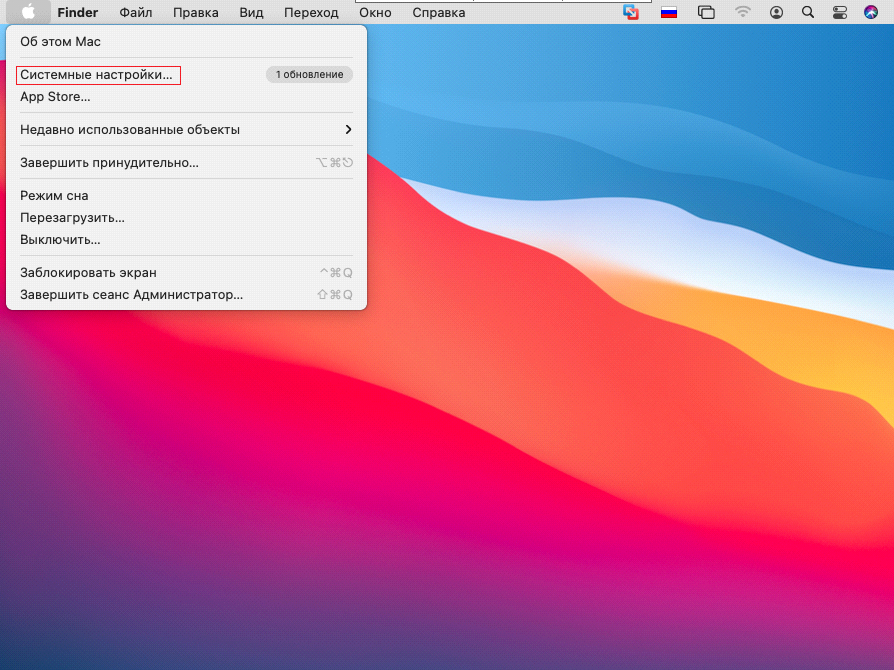
Далее выбираем общий доступ:
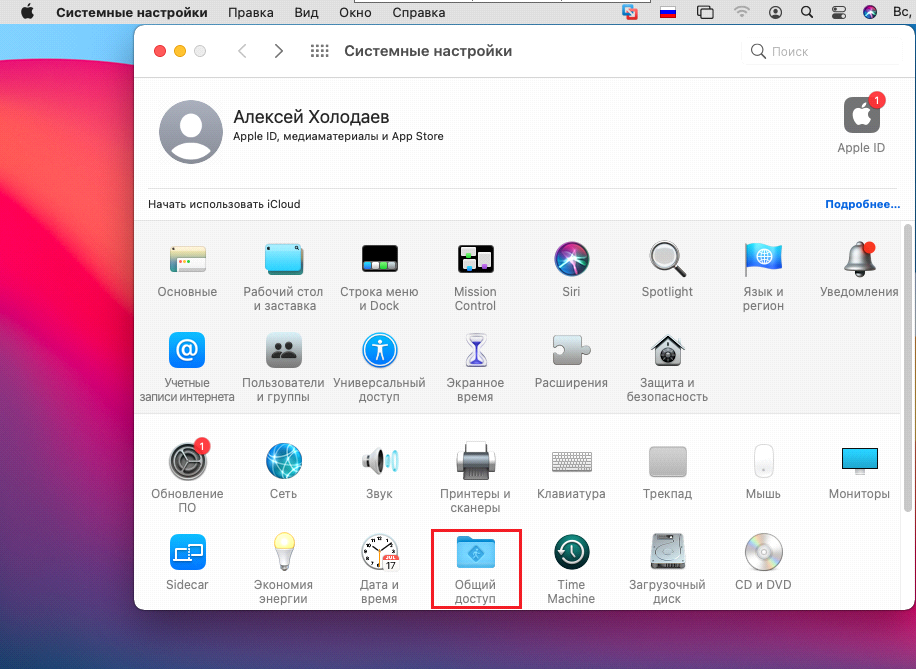
Включаем функцию «Общий экран» и переходим в настройки компьютера

Включаем опцию “любой пользователь может запросить разрешение управлять экраном” и задаём пароль в пункте “Пользователи VNC могут получить управление экраном по паролю”
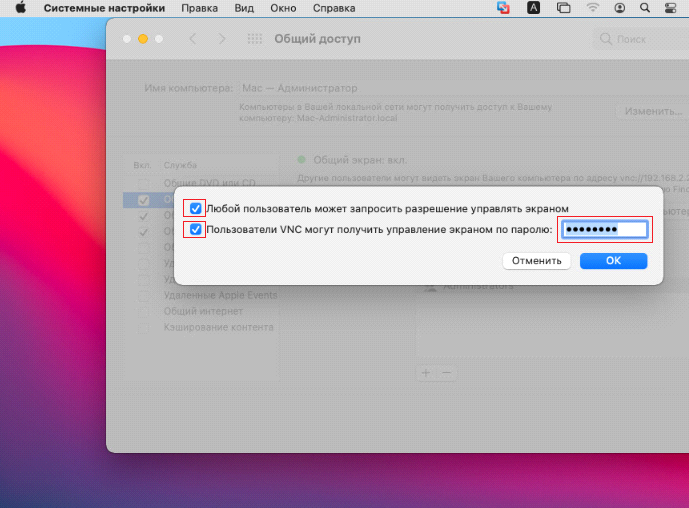
Теперь загрузим необходимые пакеты.
Нам требуются xRDP и xOrgRDP в формате исходного кода.
Загрузить их можно отсюда (tar.gz архивы). После загрузки переместим данные архивы в папку, которую мы ранее создали, и извлечём их.
cp /Users/admin/Downloads/xrdp-0.9.11.tar /Users/admin/Documents/xrdp/
tar -xvf xrdp-0.9.11.tar
rm xrdp-0.9.11.tar
cp /Users/admin/Downloads/xorgxrdp-0.2.11.tar /Users/admin/Documents/xrdp/
tar -xvf xorgxrdp-0.2.11.tar
rm xorgxrdp-0.2.11.tarСборка xRDP
Запустим Bootstrapper и сконфигурируем сборку с помощью OpenSSL. Затем запустим make установщик.
Если вы получаете ошибку на этом шаге, то скорей всего это связано с неправильным экспортом OpenSSL CPPFLAGS.
Сборка xOrgRDP
Запустим Bootstrapper и сконфигурируем сборку так, чтоб она происходила при помощи OpenSSL. Затем запустим make установщик.
cd ../xorgxrdp-0.2.11/
./bootstrap
./configure PKG_CONFIG_PATH=/opt/X11/lib/pkgconfig
make
sudo make installЕсли вы столкнулись с ошибкой, убедитесь, что вы перезапустили сессию после установки сервера xQuartz X11. Если вы получаете ошибку /opt/X11/include/xorg/dixfontstr.h:30:10:fatal error ‘X11/fonts/libxfont2.h’ file not found, необходимо поправить файл dixfontstr.h, прописав #include “/opt/X11/fonts/libxfont2.h” вместо #include “/X11/fonts/libxfont2.h”.
xRDP сервер почти готов. Теперь необходимо настроить его. Давайте откроем файл xrdp.ini.
sudo vi /etc/xrdp/xrdp.iniНайдём секцию в файле со всеми типами сессий.
[Xorg]
name=Xorg
lib=libxup.so
username=ask
password=ask
ip=127.0.0.1
port=-1
code=20
[Xvnc]
name=Xvnc
lib=libvnc.so
username=ask
password=ask
ip=127.0.0.1
port=-1
#xserverbpp=24
#delay_ms=2000
[vnc-any]
name=vnc-any
lib=libvnc.so
ip=ask
port=ask5900
username=na
password=ask
#pamusername=asksame
#pampassword=asksame
#pamsessionmng=127.0.0.1
#delay_ms=2000
[neutrinordp-any]
name=neutrinordp-any
lib=libxrdpneutrinordp.so
ip=ask
port=ask3389
username=ask
password=ask
Я буду подключаться через модуль Xvnc. Используем библиотеку libvnc.dylib вместо libvnc.so. Я закомментирую все модули, которые не буду использовать. Вот так будет выглядеть изменённая секция с типами сессий в файле xrdp.ini.
#[Xorg]
#name=Xorg
#lib=libxup.so
#username=ask
#password=ask
#ip=127.0.0.1
#port=-1
#code=20
[Xvnc]
name=Xvnc
lib=libvnc.dylib
username=ask
password=ask
ip=127.0.0.1
port=5900
xserverbpp=24
#delay_ms=2000
#[vnc-any]
#name=RDP to VNC Connector
#lib=libvnc.so
#ip=127.0.0.1
#port=5900
#username=ask
#password=ask
#xserverbpp=24
#pamusername=asksame
#pampassword=asksame
#pamsessionmng=127.0.0.1
#delay_ms=2000
#[neutrinordp-any]
#name=neutrinordp-any
#lib=libxrdpneutrinordp.so
#ip=ask
#port=ask3389
#username=ask
#password=askПримечание: В редакторе vi нажмите клавишу «i», чтобы войти в режим редактирования. Чтобы сохранить и выйти, нажмите «ESC» и введите :wq!
Теперь запустим демоны xRDP и xRDP-sesman. Они находятся по пути /usr/local/sbin/.
Выполним следующие команды:
sudo /usr/local/sbin/xrdpsudo /usr/local/sbin/xrdp-sesmanПробуем подключиться по RDP. Вводим логин и пароль, нажимаем ENTER.
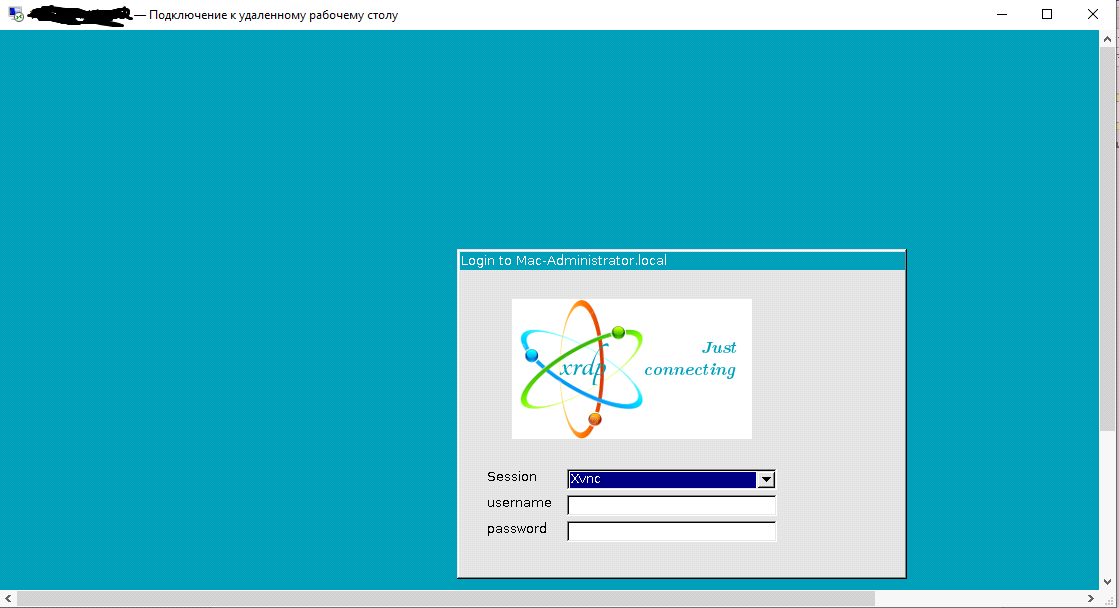
Если у вас появилось окно авторизации MacOS, значит, всё работает правильно.

Если у вас возникают какие-либо ошибки, смотрите логи. Они находятся по пути:
/var/logs/xrdp.log
/var/logs/xrdp-sesman.logВот таким способом можно предоставить доступ на MAC OS по протоколу RDP. Спасибо за внимание!
Что ещё интересного есть в блоге Cloud4Y
→ История Game Genie — чит-устройства, которое всколыхнуло мир
→ Как я случайно заблокировал 10 000 телефонов в Южной Америке
→ Странные продукты Apple
→ WD-40: средство, которое может почти всё
→ Как ИИ учится рисовать аниме
Подписывайтесь на наш Telegram-канал, чтобы не пропустить очередную статью. Пишем не чаще двух раз в неделю и только по делу.
Connecting your Windows computer to a Mac can seem daunting, but it can enhance your productivity and facilitate file sharing and collaboration. Whether you need to access files on a Mac or utilize software applications exclusive to macOS, this guide will provide a comprehensive overview of how to establish a connection between the two systems smoothly.
Understanding the Basics of Cross-Platform Connectivity
Before diving into the technical steps, it’s essential to grasp the basics of connectivity between Windows and Mac. Both operating systems have unique features and protocols, which means that the way they handle files and network communications can differ significantly.
The Importance of File Sharing and Remote Access
Connecting to a Mac from a Windows PC allows users to:
– Access files: Easily retrieve files stored on a Mac.
– Run applications: Use software that is otherwise unavailable on Windows.
– Collaborate: Work together on projects by sharing documents and resources.
Having access to both systems opens up a world of possibilities, whether for professional tasks or personal use.
Preparing Your Devices for Connection
Before you can connect your Windows device to a Mac, there are several prerequisites and preparations you need to make on both devices.
Step 1: Network Setup
Both computers must be connected to the same network. This can be a local Wi-Fi network or via an Ethernet cable. To check your network connection:
- On Windows: Click on the Wi-Fi icon in the system tray to confirm you are connected to the same network as your Mac.
- On Mac: Click on the Wi-Fi icon in the menu bar to verify the connection.
Step 2: Enable File Sharing on the Mac
To connect from Windows, file sharing must be enabled on the Mac. Here’s how:
- Go to System Preferences from the Apple menu.
- Click on Sharing.
- In the window that appears, check the box next to File Sharing.
- Click Options… and ensure that Share files and folders using SMB is checked.
- Select the users you want to allow access and set the appropriate permissions.
Step 3: Obtain the Mac’s IP Address
You need the IP address of the Mac to establish a connection. To find this:
- Open System Preferences.
- Click on Network.
- Select the active network connection (like Wi-Fi or Ethernet).
- The IP address is displayed on the right.
Note this IP address, as you will need it to connect from your Windows machine.
Connecting to a Mac from Windows
Now that you have prepared both devices, let’s proceed with the actual connection process from your Windows PC.
Method 1: Using File Explorer
The File Explorer in Windows allows you to connect to shared folders on a Mac quickly. Follow these steps:
- Open File Explorer on your Windows PC.
- In the address bar, type
\\<MAC_IP_ADDRESS>(replace<MAC_IP_ADDRESS>with the actual IP address you noted earlier). - Press Enter.
- You may be prompted for a username and password. Use the credentials of the Mac account that has permission to access the shared folders.
- After entering the credentials, you should see the shared folders available on the Mac.
This method facilitates easy sharing of files and folders without needing third-party software.
Method 2: Using Remote Desktop Protocol (RDP)
If you want to control a Mac remotely from a Windows computer, you can use a remote desktop application. Here’s how to set it up:
Step 1: Install Remote Desktop Software on the Mac
There are several options available, but one of the most popular choices is TeamViewer or Microsoft Remote Desktop. For TeamViewer:
- Go to the TeamViewer website and download the macOS version.
- Install and follow the setup instructions.
Step 2: Install RDP Client on Windows
If you choose Microsoft Remote Desktop:
- Go to the Windows Store and search for Microsoft Remote Desktop.
- Download and install it.
Step 3: Connect to Mac from Windows
- Open Microsoft Remote Desktop on your Windows PC.
- Click on Add PC.
- Enter the Mac’s IP address and any required credentials.
- Click Connect.
Now you can remotely control the Mac and navigate through the system as if you were sitting right in front of it.
Using Third-Party Applications for Enhanced Connectivity
While the native methods discussed are efficient, you might consider third-party solutions for added functionality and ease of use. Software like Parallels Access or AnyDesk can provide streamlined connectivity and even allow you to run Windows applications on a Mac.
Popular Third-Party Options
- Parallels Access: Offers remote access and allows you to use software from both platforms seamlessly.
- AnyDesk: Provides a fast, reliable connection for remote access with low latency.
These applications typically require installation on both the Windows and Mac systems, so ensure that you follow the official installation guides provided by the software vendors.
Transferring Files Between Windows and Mac
Once the connection is established, transferring files between the two systems can be easy. Here are a few methods to do this effectively.
Using Shared Folders
If you’ve shared specific folders on your Mac as described earlier, you can transfer files by dragging and dropping files between the shared folders from Windows and Mac.
Utilizing Cloud Services
- Dropbox: Upload files to Dropbox on either machine, then access them from the other.
- Google Drive: Similar to Dropbox, Google Drive allows you to synchronize files between both systems easily.
These cloud services also provide the added benefit of backup and easy access from multiple devices.
Troubleshooting Common Connectivity Issues
Despite careful preparation and setup, you may occasionally encounter issues when attempting to connect. Here are some common problems and their solutions.
Problem 1: Unable to Connect to the Mac
- Solution: Ensure that both computers are on the same network and that file sharing is correctly configured on the Mac. Double-check the IP address and the sharing permissions.
Problem 2: Authentication Errors
- Solution: Confirm that you are using the correct username and password for the Mac account that has been granted access. Remember that usernames are case-sensitive.
Problem 3: Slow Connection Speed
- Solution: Check the network speed. If you’re on Wi-Fi, try switching to a wired connection or moving closer to the router.
Conclusion
Connecting to a Mac from Windows can vastly improve your workflow and provide users with the best of both operating systems. By following the steps outlined in this guide, you can ensure a smooth connection process, share files seamlessly, and even control your Mac remotely. Always remember to keep your software updated and consult your device manuals for any additional specifics.
By embracing cross-platform connectivity, you can unlock a world of collaborative potential and productivity, making both your Mac and Windows machines work harmoniously together. Whether for professional use or personal projects, knowing how to connect these two systems sets a foundation for a more integrated digital life.
What are the different methods to connect to a Mac from Windows?
To connect a Windows PC to a Mac, you have several methods available, including using Remote Desktop, file sharing, and third-party applications like TeamViewer or Chrome Remote Desktop. Each of these options has its own setup process and capabilities, so the best choice depends on your specific needs—whether you’re looking to control the Mac remotely, access files, or conduct collaborative work.
For instance, if you want to access files on the Mac from your Windows machine, you could enable file sharing on the Mac and connect to it via the Windows File Explorer. Alternatively, if remote control is required, applications like TeamViewer can facilitate direct access without needing to configure IP addresses or firewall settings.
How to set up file sharing between Windows and Mac?
Setting up file sharing requires you to enable the feature on your Mac first. You can do this by going to “System Preferences,” clicking on “Sharing,” and then checking the box next to “File Sharing.” After that, you can specify which folders you want to share and set permissions to allow read or write access for different users.
On the Windows side, you will need to access the shared folders by entering the Mac’s IP address in the File Explorer. You can do this by using the format \\<IP Address of Mac>. A dialog box will prompt you to enter the username and password of your Mac account before granting access to the shared folders.
Can I use Remote Desktop to connect to a Mac from Windows?
Yes, you can use Microsoft Remote Desktop to connect to your Mac from a Windows PC, but you’ll first need to install the Remote Desktop service on the Mac. You can download the Microsoft Remote Desktop app from the Mac App Store and set it up accordingly. After installation, you’ll activate the “Remote Management” feature in the Sharing settings on your Mac to allow incoming connections.
Once configured, you can access your Mac by opening the Remote Desktop client on your Windows PC and entering the Mac’s IP address or name. Keep in mind that you’ll need to provide valid credentials to establish the connection successfully.
What additional software can facilitate connection between Windows and Mac?
There are several third-party software options that simplify the process of connecting a Windows PC to a Mac. Popular choices include TeamViewer, Chrome Remote Desktop, and AnyDesk. These applications allow for remote access and screen sharing, making it easier to work across different operating systems.
Most of these tools are user-friendly and offer cross-platform compatibility, meaning that you can connect even if you have various versions of operating systems running on both machines. Installing the software is usually straightforward—simply download and install it on both your Mac and Windows computer, then follow the provided instructions to establish a connection.
What network settings are required for a successful connection?
For a successful connection between a Windows PC and a Mac, both devices must be on the same network unless you are using a remote access application that works over the internet. Ensure that your firewall settings on both operating systems allow connections. You may need to adjust settings in both Windows Defender Firewall and macOS firewall to permit file sharing or remote desktop access.
Additionally, it’s important to know the IP addresses of both machines and potentially configure port forwarding if you’re trying to connect remotely through your router. Keeping network configurations up to date can help prevent connectivity issues in the future.
Are there security concerns when connecting to a Mac from Windows?
Yes, security is a crucial aspect to consider when connecting a Windows PC to a Mac. When enabling file sharing or remote desktop functionalities, make sure that you set strong passwords and configure permissions carefully to prevent unauthorized access. Always be aware that enabling these features can expose your Mac to vulnerability if not properly managed.
Furthermore, consider using a Virtual Private Network (VPN) for added security when connecting over public or unsecured networks. VPNs encrypt your internet traffic, making it difficult for potential attackers to intercept sensitive data transmitted between your devices.
What are some troubleshooting tips for connection issues?
If you’re experiencing connectivity issues when trying to connect your Windows PC to a Mac, first check your network settings to ensure both devices are on the same network. Verify that you have enabled file sharing or remote desktop on your Mac, and ensure that any necessary ports are open in your firewall settings.
If problems persist, you may want to restart both devices or reset your network router to refresh the connection. Additionally, it can help to temporarily disable firewalls or antivirus software to see if these settings are causing the issue, but remember to enable them afterwards for ongoing protection.
If you’re a Windows desktop user and need to access your Mac desktop remotely, there are a few ways to do it.
We’ll show you how to connect to your Mac from a Windows PC using a Remote Desktop client as well as some third-party apps.
Do you ever find yourself needing to access a file or application on your desktop computer but you’re not at home? Or maybe you’re traveling and don’t want to lug your laptop with you.
That’s where Parallels Access comes in.
It’s the fastest, simplest, and most reliable way to remotely access your computer from anywhere.
You’ll be able to access all your files, applications, and computers in one place. Plus, it’s secure so you can rest assured that your data is safe.
We’ll also cover some tips on how to control your Mac remotely.
So, whether you’re at home or away, you can easily access and use your Mac desktop from anywhere.
What Is Remote Desktop Connection for Mac?
Remote connection means many things. You can access certain files in an Apple Mac remotely using shared file systems, via FTP.
Screen sharing can also be considered a remote connection since you can see the screen of the computer by sharing the screen remotely via Zoom. But there’s no way to regulate it.
We’ll be examining remote connections for a MacBook with no physical presence.
Can You Connect to a Mac with Remote Desktop Access?
You can use Remote Desktop to connect to a Mac from another computer.
To do this, your administrator and client computers must meet certain requirements.
Mac computers must be running OS X 10.10.5 or later, and the Remote Desktop client software must be version 3.6 or later for Macs. This will allow you to exercise complete control over the remote machine.
You can use Remote Desktop to access files and applications on the remote computer, as well as to share your Mac’s screen with others or provide remote support.
While it is possible to remote control a Mac from Windows, it requires a few extra steps.
First, you need to enable remote login on your Mac.
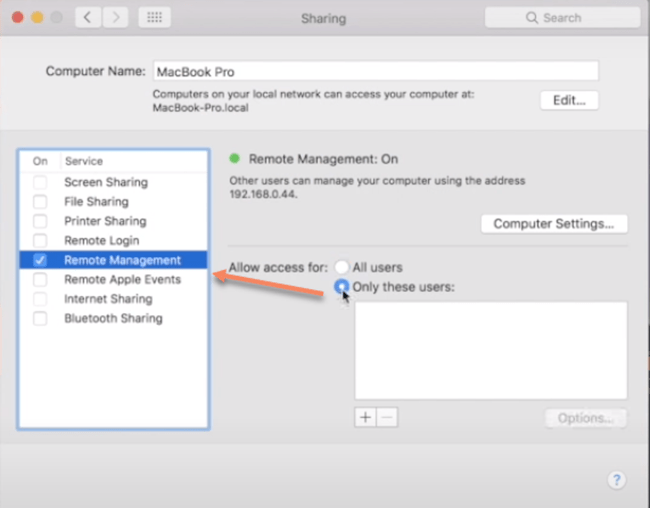
This can be done by going to System Preferences > Sharing.
Next, select Remote Login and choose which users you want to have access.
Once this is done, you will be able to connect remotely to your Mac from another computer using a Secure Shell (SSH).
This will allow you to use a Secure File Transfer Protocol (SFTP) to remotely access files on your Mac.
How Do I Access a Mac from Windows?
Macs and Windows PCs have always been different beasts when it comes to operating systems, but in recent years, it’s become easier to use a Mac from a Windows PC.
If you need to access files or applications on a Mac from a Windows computer, there are a few different ways you can go about it.
One of the easiest methods is to simply use the built-in file-sharing features of both operating systems.
On the Windows computer, open File Explorer, click Network, and locate the Mac you want to connect to.
Double-click the Mac, then enter the account name and password for the user account. It may take a moment for the Windows computer to show that the Mac is on the network.
Once connected, you can browse the Mac’s file system and even launch applications remotely.
Another option is to use a third-party application like VMware Fusion or Parallels Desktop.
These utilities create a virtual environment on your PC that allows you to run macOS alongside Windows. This can be useful if you need to use specific Mac-only software, but it does require more processing power and memory than simply using file sharing.
Whichever method you choose, connecting to a Mac from a PC is relatively straightforward and can be done without any headaches.
How to Access Your Mac from Another Location
File Transfer Protocol (FTP)
The best technique, but also the easiest method, in sharing files from a Macbook is FTP. You can do either using FTP Client or Terminal with much more convenience. FTP is available as an easy-to-use client.

The robust file manager ForkLift provides all FTP functionality but takes this to an entirely new level and can be an excellent replacement for the Search tool, with the ability to search quickly, preview instantly, and file compare.
DCommander combines speed with the reliability to manage thousands, if not millions, of documents, schedule backups, and even automate transfer processes.
Allow Remote Login to Your Mac from Another Computer
For devices using similar Mac OSes, remote Mac access is possible via Secure Shell (SSH). This allows access from a computer to the computer via SFTP.
You can access your computer remotely using a different computer by entering your username and password. Write these down and keep it secure, as the ability to use Macs makes it more difficult to access.
Do You Need a VPN?
Security should be the priority for every Mac user if they’re using an Internet connection.
In general, it’s advisable to always use a VPN connection with public Wi-Fi networks.
The ability to access any Mac computer is restricted to the ‘View Only’ version — if you don’t want the passwords in your computer.
Having password information hidden on the internet may pose huge security risks to your identity and personal information.
How to Use Your iOS Device As a Remote Mouse?
You can use an iPhone or iPad to control a Mac remotely, just as a mouse could use a desktop or laptop.
Remote Mouse allows you to change an iPhone or iPad to a computer mouse.
Though remote access is the most beneficial, since the closer the device, the better the connection is, it also is possible from any location worldwide if the network has sufficient security and speed.
How to Stay on the Same Page with Screens?
In the modern workplace, collaborations are becoming very important.
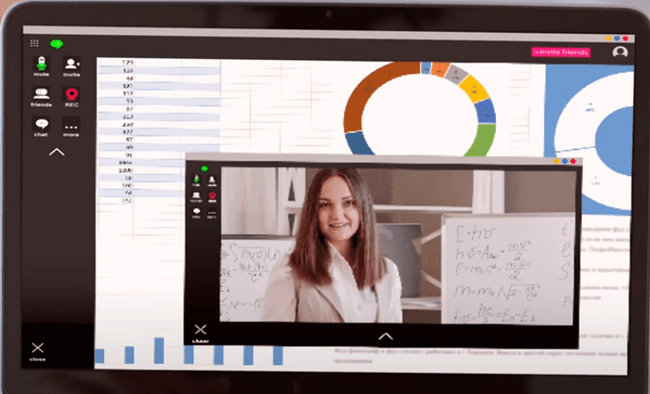
Screen technology makes remote computing possible without the need for a computer or location.
Whatever business destination you travel to, keep yourself safe when it comes to storing data.
Native MacOS File Sharing
Usually, people have no idea that Macs are capable of sharing files with other computers or laptop systems.
For this functionality, click on Share in System Preferences to check file share.
AirDrop
Although it doesn’t provide an ideal solution, AirDrop can share files, easily, between different iPhone and iPad devices.
Choose go and then air-drop on both Macs and incoming computers.
Once you have the receiver logo, drag the desired file into the folder for sending.
Share Files between Devices
There have been many ways of sharing and transferring data.
Because emails exist everywhere, they remain the default format for file sharing, although there are obvious shortcomings.
Dropshare
You can send files from Mac to Mac directly to iCloud without needing to download anything, but Dropshare.
The app supports multiple cloud providers, including Dropbox and Google Drive, and can easily transfer your files to its menu bar.
Allow Others to Access Your Computer Using Apple Remote Desktop
Apple Remote Desktop is a powerful tool that allows you to remotely control another Mac.
It can be used for a variety of tasks, such as providing remote technical support or simply accessing files on a different computer.
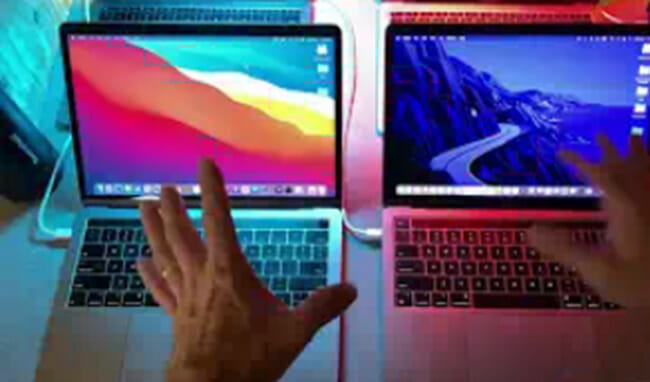
If you need to allow others to access your Mac using Apple Remote Desktop, you can do so by enabling the “Remote Management” feature in Sharing preferences. This will give users the ability to control your Mac as if they were sitting in front of it.
You can select which tasks they are allowed to perform, such as viewing the screen or opening apps.
Enabling this feature can be helpful if you need to provide remote assistance to someone, or if you simply want to make it easier for others to access your computer.
FAQs
Can a Mac Connect to Windows 10 or 11 Remote?
Microsoft’s Remote Desktop tool is a free way to remotely connect to a Windows 11 computer from your Mac. It’s easy to set up and use, and it lets you access all your Windows apps, files, or anything else on Windows directly from your macOS machine.
You can even use the Microsoft Remote Desktop client to remotely connect to other PCs, such as a work PC from your home computer. All you need is the IP address of the PC you want to connect to and a few other pieces of information.
Once you have those, you can be up and running in minutes. And if you ever need to access your Windows PC from another location, such as a coffee shop or hotel room, the Microsoft Remote Desktop tool makes it easy to do so.
Whether you’re working from home or on the road, the Microsoft Remote Desktop tool is a valuable way to stay connected to your Windows PC.
How Do I Connect My Mac to Windows?
Macs and PCs have always been different, but it’s easier than ever to connect a Mac to Windows.
With the latest operating systems, all you need is a LAN cable or WiFi connection.
Once you’re connected, you can access files on the other computer just like you would any other server.
In the Finder on your Mac, choose Go > Connect to Server.
Click Browse, then find the computer’s name in the Shared section of the Finder sidebar.
Click it to connect.
You may have to click ‘All’ to view all of the connected computers.
Click ‘Connect As’ after you’ve located the shared computer or server.
In some cases, you need the network area or workgroup for the shared computer. If you don’t have this information, contact the computer’s owner or your network administrator.
If needed, provide your password and username.
Next, select ‘shared folders’ or ‘volumes’.
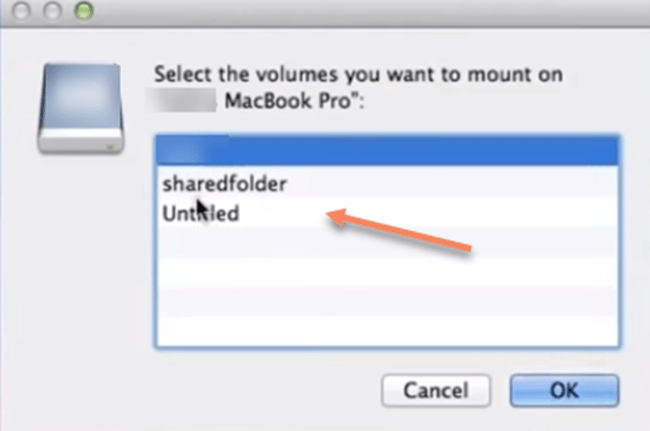
To make it easier to connect to the computer in the future, select “Remember this password in my keychain” to add your username and password for the computer to your keychain.
Now, you can access files on the other computer just like you would any other server.
Can a PC User Switch to a Mac?
These days, switching between operating systems is easier than ever.
If you’re considering making the move from Windows to Mac, there’s no need to worry about losing all your files and preferences.
With the Windows Migration Assistant, you can transfer everything from your Windows PC to your new Mac with just a few clicks.
All you need to do is open the Migration Assistant on both devices and follow the prompts.
Another option is to use third-party migration software. This type of software can typically transfer more types of data than the Windows Migration Assistant, but it may be more expensive.
In no time, you’ll be up and running on your new Mac with all your familiar files and settings intact.
Whichever method you choose, migrating from Windows to Mac is relatively straightforward and should allow you to transition with minimal fuss.
Conclusion
If you’re looking for an easy way to connect to and control your Mac from a Windows computer, Remote Desktop is the answer.
With just a few clicks, you can be up and running with full access to all of your files and programs.
Have you tried using Remote Desktop to connect to your Mac?
In today’s digital landscape, the ability to seamlessly work across different operating systems is more than a convenience—it’s a necessity. With the increasing prevalence of remote work and the diverse ecosystem of software and applications, the need to bridge the technological divide between Mac and Windows platforms has never been more critical.
This article will tell you how to remote control Mac from Windows computer. Let’s dive in.
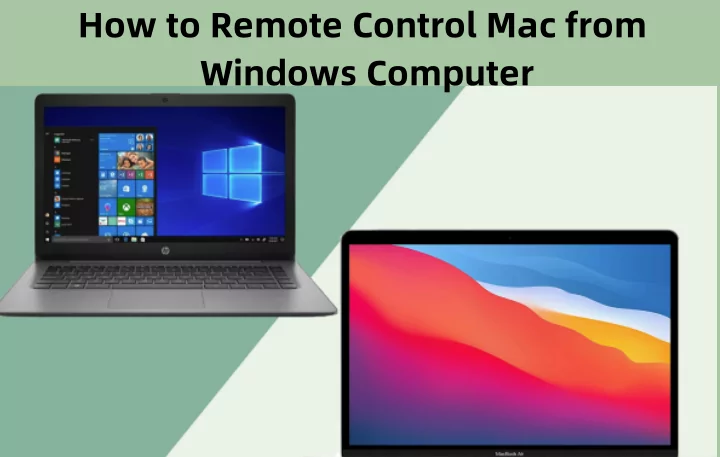
- Part 1 : Can You Remote into a Mac from Windows
- Part 2 : How to Remote Control Mac from Windows
- Method 1 : Microsoft Remote Desktop
- Method 2 : Chrome Remote Desktop
- Method 3 : VNC Viewer
- Method 4 : AnyDesk
- FAQs on Remote Access Between Mac and Windows
Part 1. Can You Remote into a Mac from Windows?
The question of whether a Windows PC can remote into a Mac is one that surfaces often in forums, discussions, and IT help desks. The answer is a resounding «Yes.» Advances in remote desktop technology have erased the boundaries that once made cross-platform access a challenging endeavor.
In this guide, you’ll learn how to control a Mac from a Windows PC. We’ll explore various methods, including Microsoft Remote Desktop, Chrome Remote Desktop, VNC Viewer, and popular remote desktop software like AnyDesk. Stay tuned to understand the steps involved in setting up these applications and tips to ensure a smooth remote access experience.
Part 2. How to Remote Control Mac from Windows
Navigating remote access between Mac and Windows might seem like a tough journey. But, connecting these two operating systems isn’t just doable; it’s a well-trodden path, thanks to several b tools. Let’s get into the nitty-gritty of how you can use these tools to make remote control from Windows to Mac not just achievable, but also smooth and user-friendly.
1Microsoft Remote Desktop
One of the most seamless ways to connect to a Mac from a Windows PC is through Microsoft Remote Desktop. This application allows Windows users to remotely connect to a Mac with ease, offering a near-native experience. The setup process involves downloading the Remote Desktop client on your Mac from the Mac App Store and ensuring your PC is configured to accept remote connections. Once set up, you can enjoy a range of functionalities like full-screen support, clipboard sharing, and audio streaming.
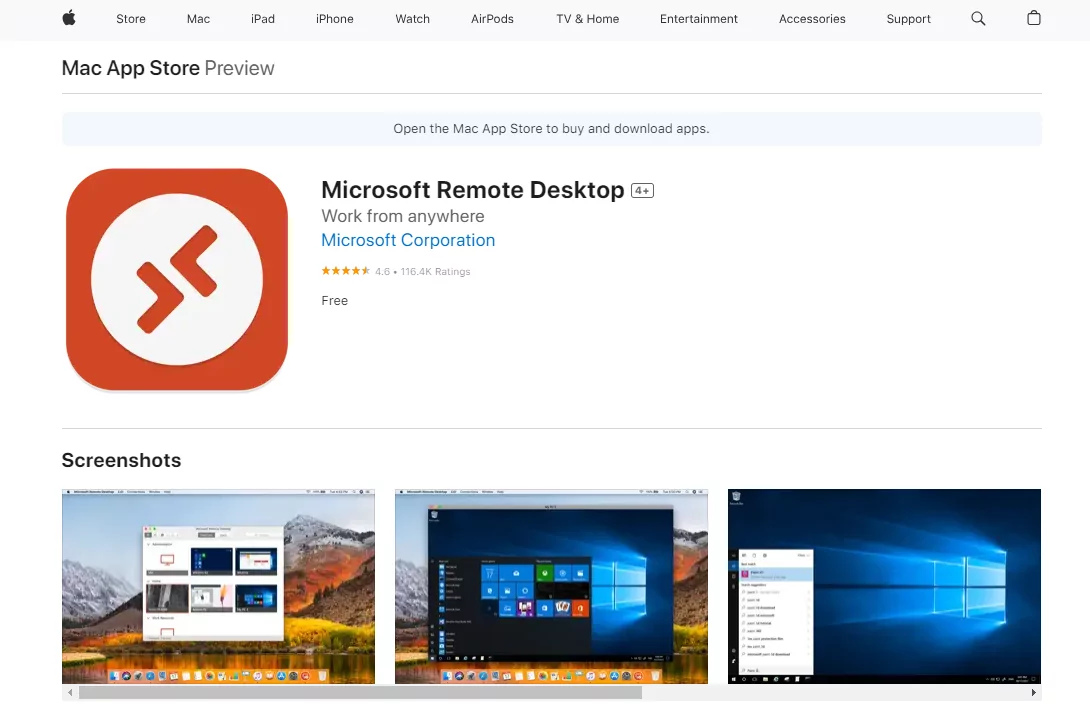
Microsoft Remote Desktop Steps
On your Mac:
- Step 1.Download the Microsoft Remote Desktop app from the Mac App Store.
- Step 2.Ensure your Mac is configured to allow remote connections via System Preferences > Sharing > Remote Management (or Screen Sharing).
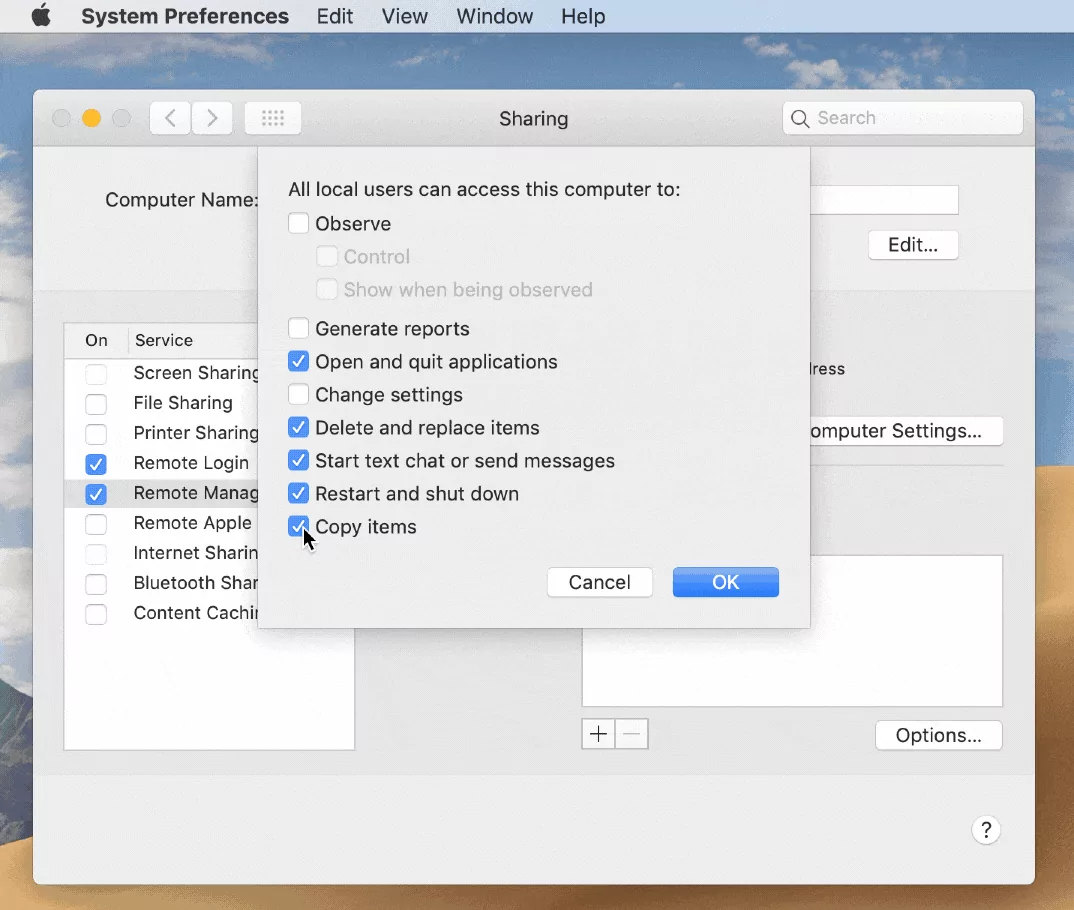
On your Windows PC:
- Step 1.Launch the Microsoft Remote Desktop app.
- Step 2.Click Add Desktop, then enter your Mac’s IP address.
- Step 3.Enter your Mac’s username and password when prompted to initiate the connection.
Pros
- Smooth integration with Windows.
- High-quality video and audio streaming.
- Secure connections leveraging Microsoft’s technology.
Cons
- Requires initial setup on both Mac and Windows devices.
- May not support certain Mac-specific gestures and features.
Ideal for : Professionals needing to access Windows applications on Mac or manage multiple devices across platforms.
2Chrome Remote Desktop
For those seeking a more straightforward setup, Chrome Remote Desktop presents an appealing solution. This web-based tool requires only a Google Chrome browser on both the Mac and Windows PC. By installing the Chrome Remote Desktop extension, users can quickly establish a connection. This method shines in its simplicity and the fact that it doesn’t tie the user down to any specific operating system or device.
Chrome Remote Desktop Steps
On both your Mac and Windows PC:
- Step 1.Install Google Chrome and navigate to the Chrome Remote Desktop web app.
- Step 2.Click on Set up remote access and follow the on-screen instructions to download the Chrome Remote Desktop host installer.
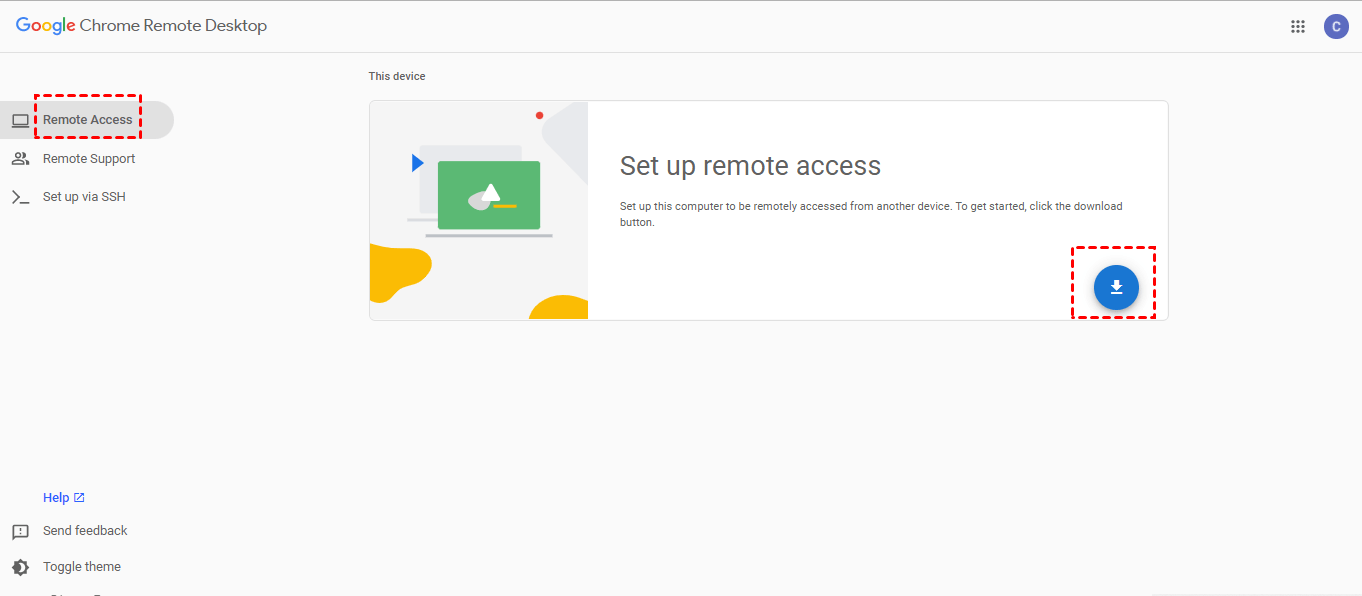
On your Mac:
- Step 1.Install the Chrome Remote Desktop host installer.
- Step 2.Follow the prompts to set up a name and PIN for your computer.
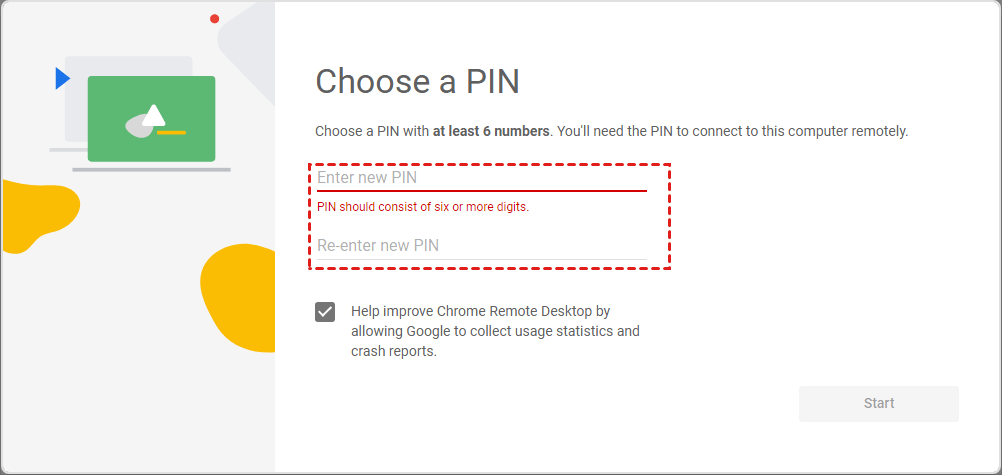
On your Windows PC:
- Step 1.Open the Chrome Remote Desktop web app, and under Remote Access, find your Mac listed.
- Step 2.Click on your Mac’s name and enter the PIN you created to start the remote session.
Pros
- Easy to set up and use.
- No cost involved.
- Accessible from any device with Chrome, including mobile.
Cons
- Relies on an internet connection, which can affect performance.
- Limited advanced features compared to dedicated apps.
Ideal for : Casual users needing occasional access to their Mac from a Windows device or those looking for a simple, cost-effective solution.
3VNC Viewer
VNC (Virtual Network Computing) Viewer offers a more technical route for remote access, catering to users with specific needs or preferences for open-source solutions. Setting up VNC involves enabling Remote Management or Screen Sharing on your Mac and installing VNC Viewer on your Windows PC. This method stands out for its compatibility across different platforms and the control it offers over connection settings.
VNC Viewer Steps
On your Mac:
- Step 1.Go to System Preferences > Sharing.
- Step 2.Check Remote Management or Screen Sharing.
- Step 3.Click Computer Settings and enable VNC viewers may control screen with password. Then set a password.
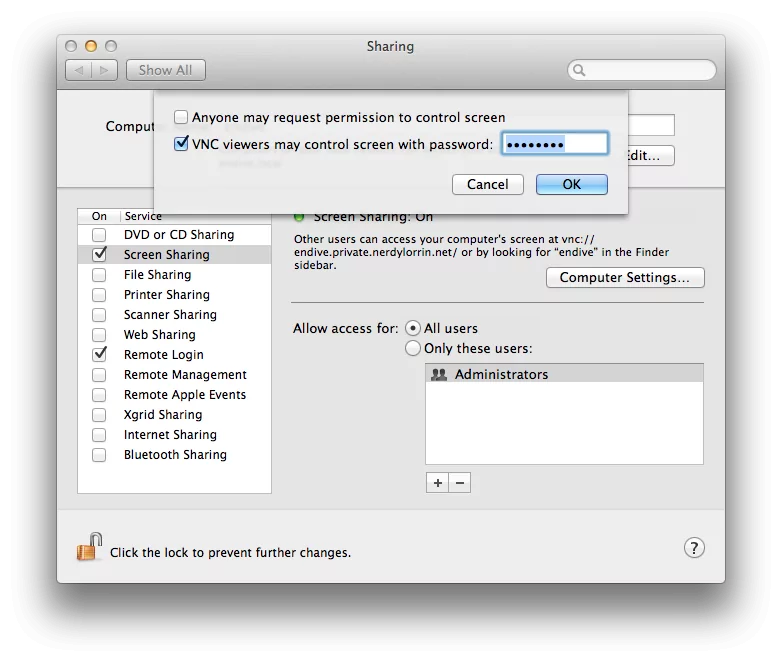
On your Windows PC:
- Step 1.Download and install VNC Viewer.
- Step 2.Enter your Mac’s IP address in VNC Viewer and connect.
- Step 3.Enter the password you set on your Mac to start controlling it remotely.
Pros
- Cross-platform support, including Linux and mobile devices.
- Free for personal use.
- Offers a high degree of customization and control.
Cons
- More complex setup process.
- Performance can vary based on network conditions.
Ideal for : Tech-savvy users or those in need of a flexible, platform-agnostic solution for remote access.
Each of these methods opens the door to a world where Mac and Windows not only coexist but work together seamlessly. Whether you prioritize ease of use, feature richness, or flexibility, there’s a solution tailored to your remote access needs.
4AnyDesk
There are also many professional remote desktop software that can help you remotely control a Mac computer from Windows easily and give you better remote access experience. Venturing further into the spectrum of remote desktop solutions, AnyDesk stands out as a formidable option for professionals and casual users alike seeking to control a Mac from a Windows environment.
Renowned for its speed and lightweight design, AnyDesk offers an intuitive platform that simplifies the remote desktop connection process. The setup involves downloading AnyDesk on both the Windows and Mac machines, with a straightforward connection interface that emphasizes quick access.
AnyDesk Steps
On both your Mac and Windows PC:
- Step 1.Download AnyDesk from the official website.
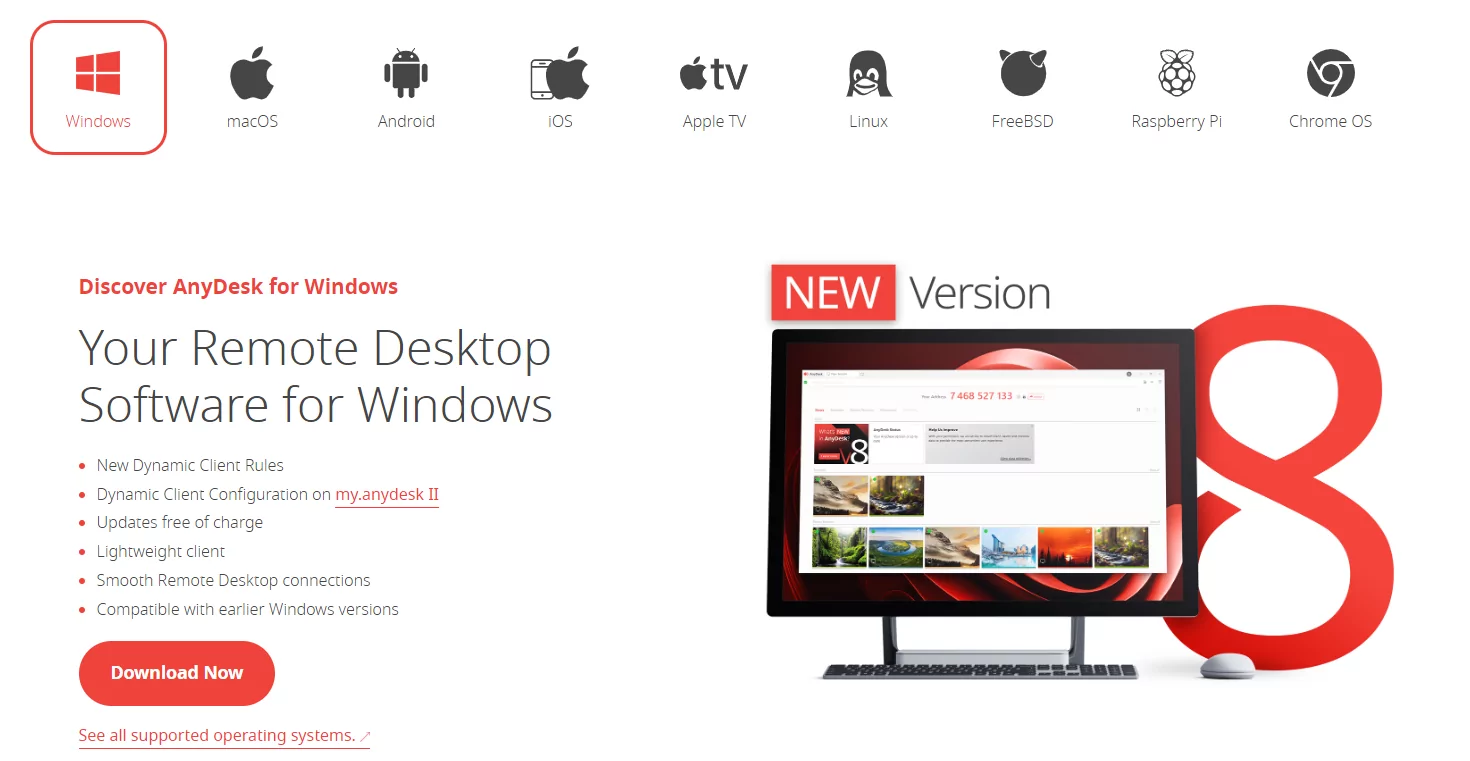
On your Mac:
- Step 1.Open AnyDesk and note down the AnyDesk Address displayed on the main screen.

On your Windows PC:
- Step 1.Open AnyDesk, enter the AnyDesk Address of your Mac, and click Connect.
- Step 2.Your Mac may prompt you to accept the connection. Once accepted, you’ll have control over your Mac from your Windows PC.

Pros
- Exceptionally fast performance, making it ideal for tasks requiring high responsiveness.
- Simple interface that lowers the learning curve for new users.
- Strong encryption and security features ensure a secure connection.
Cons
- The free version has limitations, which might necessitate an upgrade for advanced users.
- Some users may require time to familiarize themselves with AnyDesk’s unique interface and features..
Ideal for : Users needing a balance between performance, ease of use, and security, especially in environments where speed and data protection are paramount.
Conclusion
The digital landscape is increasingly interconnected, with workflows extending across various operating systems. The ability to remotely access a Mac from a Windows PC opens up a world of flexibility and productivity, breaking down barriers between platforms. Whether you’re a professional in need of accessing specific applications, or simply seeking to manage your devices across different ecosystems, the solutions discussed provide a comprehensive toolkit for bridging the gap between Mac and Windows.
And if you are also seeking solutions for remote controlling an Android device, then AirDroid Remote Support will be your best choice.
FAQs on Remote Access Between Mac and Windows
What is the RDP equivalent for Mac?
For Mac users looking for a Remote Desktop Protocol (RDP) equivalent, Microsoft Remote Desktop offers a seamless experience that closely mirrors the RDP functionality on Windows. It provides a robust solution for accessing Windows desktops and applications directly from a Mac.
What is the difference between VNC and RDP on Mac?
The key difference between VNC and RDP lies in their approach to remote access. VNC mirrors the remote desktop’s display and sends it over the network, essentially broadcasting a live feed of the desktop. RDP, on the other hand, creates a virtual session that interacts with the server, offering a more integrated and potentially smoother experience. VNC is generally more versatile across different platforms, while RDP may offer better performance and a more Windows-centric experience.
Is RDP free on Mac?
Yes, Microsoft Remote Desktop is available for free on the Mac App Store, providing Mac users with a cost-free option to access Windows environments. However, it’s important to note that while the client is free, accessing a Windows machine remotely may require a valid license for the Windows OS, depending on the specific use case and setup.
Connecting remotely to a Mac from a Windows PC can very well be one of the most valuable troubleshooting, management, and collaboration skills in today’s digital workspace. Whether you’re a professional needing access to vital software or simply looking to help a friend solve technical issues, knowing how to establish this connection can significantly enhance productivity. This guide will delve deep into the steps, tools, and nuances involved in achieving a successful remote connection from Windows to a Mac.
When working in a mixed-OS environment, you may find yourself needing access to a Mac for various reasons:
-
Software Compatibility: Certain applications and tools are exclusive to macOS. Remote access means you can use these tools from a Windows machine.
-
Technical Support: If someone requires assistance on their Mac, a remote connection allows you to guide them easily.
-
File Access and Management: Accessing files stored on a Mac from your Windows PC simplifies file-sharing, especially in a collaborative setting.
Understanding these motivations sets the stage for a more focused approach.
Essential Tools for Remote Connection
To successfully connect to a Mac from Windows, specific functionalities need to be enabled and tools must be available. Here are some essential tools to consider:
-
Remote Desktop Protocol (RDP): This is the built-in connectivity feature on Windows. While macOS doesn’t natively support RDP, compatible tools bridge the gap.
-
VNC (Virtual Network Computing): A popular option for remote desktop sharing, VNC works across different operating systems, including macOS and Windows.
-
Third-party Applications: Various applications like TeamViewer, AnyDesk, and Chrome Remote Desktop can simplify remote access.
These tools provide flexibility, allowing users to choose what best suits their needs.
Setting Up Your Mac for Remote Access
Before you can initiate a remote connection, you must configure your Mac to allow incoming connections. This is a pivotal step that ensures security and functionality.
1. Enable Remote Management on Mac
To commence, follow these steps:
- Open System Preferences on your Mac.
- Navigate to Sharing.
- Check the box next to Remote Management. This will enable other users to connect to your Mac.
- Decide on the access level you wish to provide (all users, specific users).
2. Configure VNC Settings
If you opt for VNC connections, adjust the settings accordingly:
- In the same Sharing menu, click on Computer Settings under Remote Management.
- Check the box to allow VNC viewers to control your screen.
- Set a strong password for VNC access, emphasizing strong password creation principles to ensure the connection’s security.
3. Check Your Firewall Settings
Make sure your firewall isn’t blocking incoming connections:
- Under System Preferences, select Security & Privacy.
- Click on the Firewall tab.
- Make necessary adjustments to allow remote connections or disable the firewall temporarily (not recommended for prolonged use).
Connecting to Mac from Windows: Step-by-Step Guide
With your Mac configured for remote access, it’s time to establish the connection from your Windows PC. Depending on the tool you choose, the process may vary slightly.
Using VNC Viewer
If you decided to use VNC, here’s a simplified process to connect:
-
Download and Install VNC Viewer: If you haven’t done so, download a VNC viewer such as RealVNC or TightVNC on your Windows PC.
-
Launch VNC Viewer: Once installed, open the application.
-
Enter the Mac’s IP Address: You’ll need the IP address of the Mac to connect. It can be found in System Preferences > Network.
-
Select Connect: Experiment with the connection settings if necessary, focusing on screen sharing and control options.
-
Enter the Password: When prompted, enter the password you set for VNC connections.
-
Establish Connection: Verify the settings and hit connect. The screen of your Mac should appear, allowing you to interact with it as if you were sitting in front of it.
Using Remote Desktop Apps
For third-party applications like TeamViewer or AnyDesk, the process is even more streamlined. Here’s a brief overview:
-
Install the Application on Both Devices: Download and install TeamViewer or AnyDesk on both your Windows and Mac systems.
-
Get the Connection ID: Open the application on your Mac. It will provide you with an ID and a password.
-
Launch the App on Windows: On your Windows PC, open the same application.
-
Input the ID: Enter the ID from your Mac into the application on Windows.
-
Enter the Password: When prompted, enter the password.
-
Connect: Click on the connect button and gain access to the Mac desktop.
Additional Tips for Secure Remote Connections
Establishing a remote connection may expose your systems to security risks. Therefore, it is critical to consider these best practices:
1. Use Strong Passwords
A robust password is your first line of defense. Always create passwords with combinations of letters, numbers, and special characters. Avoid using easily guessed phrases.
2. Enable Firewall on the Mac
As mentioned earlier, while adjusting your firewall settings, ensure that your Mac is protected. Disable it temporarily only if absolutely necessary and avoid prolonged periods without protection.
3. Regularly Update Software
Keep both your macOS and Windows software up-to-date. This practice will ensure you have the latest security patches and features.
4. Utilize a VPN
When possible, use a Virtual Private Network (VPN) to enhance security while accessing sensitive data remotely. A VPN encrypts your connection, making it more difficult for attackers to intercept data.
Troubleshooting Common Connection Issues
During your remote connection experience, you may encounter a few issues. Here are a few troubleshooting tips:
1. Verify Network Settings
One common issue may be that you are not connected to the same network. Ensure both devices are on a local network or connected to the internet for remote connections.
2. Inspect Firewall and Security Settings
Double-check that the firewall settings on the Mac allow connections through the chosen protocol (like VNC).
3. Restart Both Machines
Sometimes, simply restarting the Windows PC and the Mac could resolve underlying issues.
4. Reassess Software Configuration
Ensure that all necessary software is properly installed and running. An error in an app’s setup can hinder connection.
Conclusion
Knowing how to connect remotely from a Windows PC to a Mac opens a world of possibilities for productivity and collaboration. Whether for personal use, technical assistance, or workspace collaboration, this skill is invaluable in the modern digital landscape. By following the steps outlined in this guide, and implementing security measures, you can ensure a smooth, secure, and effective remote connection experience.
Remember, every digital connection carries its risks, so always prioritize security. Keep learning and improving your remote access skills, as this capability will undoubtedly enhance your versatility in navigating today’s technology-driven world.
What are the requirements for remotely connecting from Windows to a Mac?
To remotely connect from a Windows machine to a Mac, you’ll need a few essential requirements in place. First, ensure that your Mac is running a compatible version of macOS that supports remote access functionalities, such as macOS Mojave or later. Additionally, you will need a stable internet connection on both devices for a seamless experience.
Moreover, you’ll require software solutions that facilitate remote access, such as Microsoft Remote Desktop or third-party applications like TeamViewer or AnyDesk. Installing and configuring these applications ensures a secure and efficient connection between your Windows PC and Mac.
How do I enable remote access on my Mac?
Enabling remote access on your Mac can be done through the System Preferences. Start by navigating to the “System Preferences” menu and selecting “Sharing.” Here, you can find the “Remote Management” option, which you need to check to allow other users to connect to your Mac. Make sure to configure who can access your Mac by setting permissions accordingly.
In addition to enabling Remote Management, consider setting a strong password for your user account and possibly restricting access to specific users for security purposes. This ensures that only authorized users can connect remotely, reducing the risk of unauthorized access to your system.
Can I use any third-party software for remote access?
Yes, there are several third-party software options available for connecting from a Windows computer to a Mac. Popular solutions include TeamViewer, AnyDesk, and Chrome Remote Desktop. Each application offers unique features, such as cross-platform compatibility, easy setup, and file transfer capabilities.
When choosing third-party software, consider factors such as ease of use, security features, and whether it supports the operating systems you are using. Most of these applications provide straightforward installation guides to help you set up the connection smoothly.
Is it possible to access files and applications on my Mac remotely?
Absolutely! When you connect your Windows PC to your Mac using remote access software, you can access your Mac’s files and applications as if you were sitting right in front of it. This functionality enables you to open documents, use software, and manage files seamlessly over the internet.
However, the performance of file transfers and application usage may depend on the speed of your internet connection. For the best experience, ensure that both the Windows and Mac devices are connected to high-speed internet. Some applications also allow file sharing and drag-and-drop features, enhancing your overall remote experience.
Will I experience any lag when connecting remotely?
The level of lag you experience while remotely connecting from Windows to your Mac can vary based on several factors, primarily the quality of your internet connection and the specifications of both devices. If both your Windows PC and Mac have high-speed internet and robust hardware, lag should be minimal.
However, if either device is operating on a slower connection, or if the remote software you are using is not optimized for performance, you may experience some delay. To reduce lag, close any unnecessary applications on both machines that could be using bandwidth or processing power, and consider using wired connections instead of Wi-Fi for more stability.
Can I secure my remote connection to protect my data?
Yes, securing your remote connection is crucial for protecting your data and ensuring privacy. Most remote access applications offer encryption and security features that you can enable. For example, using a strong password and two-factor authentication (2FA) can significantly enhance the integrity of your connection.
Additionally, regularly updating your remote software and operating systems will ensure that you benefit from the latest security patches. It’s also advisable to use a VPN when accessing your Mac remotely for an added layer of security, especially when connecting over public Wi-Fi networks.
What should I do if I encounter connection issues?
If you encounter connection issues while trying to access your Mac from your Windows PC, start by checking the basic connectivity settings. Ensure both devices are connected to the internet and that the remote access application is properly installed and configured. Restarting both devices can also resolve many connection problems.
If the basic troubleshooting steps do not work, check your firewall settings on both devices to ensure that the remote access application is not being blocked. Review the application’s documentation for specific troubleshooting tips, and consider reaching out to the software’s customer support if the issue persists.
